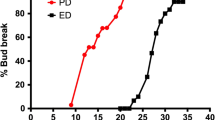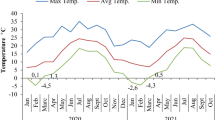Abstract
The lack of more sustainable options for inducing bud break in grapevines in mild winter regions is a limiting factor for local viticulture due to restrictions on the use of agrochemicals. Within this context, an experiment was conducted to evaluate the effects of a hydrolate obtained from Gallesia integrifolia (a native Brazilian tree) on the bud break of grapevines cv. Ives. The experiment was conducted in a vineyard located in Marialva, Paraná, Brazil, over two consecutive crop cycles: 2011 (September/December) and 2012 (February/May). The treatments consisted of the following doses of Gallesia hydrolate (GH): 0, 100, 150, 200, and 250 mL L−1, as well as 30 mL L−1 of garlic extract and 20 mL L−1 of hydrogen cyanamide, which were used as positive controls. The following variables were evaluated: sprouting percentage per plant, number of clusters per plant, cluster mass, yield (t ha−1), catalase and peroxidase activities. The GH treatments improved bud break in cv. Ives during both crop cycles, demonstrating quadratic effects relative to the applied doses. The same effect was verified for the number of clusters and for the yield. Twenty-four hours after the treatments, a quadratic effect for peroxidase and catalase activity was verified relative to the GH doses applied. For peroxidase activity, the treatment at 200 mL L−1 GH resulted in a 57 % reduction relative to the control. The most abundant component found in GH was dimethyl disulfide. Based on these results, GH at 150 mL L−1 could be a promising alternative to the currently used methods for promoting bud break in cv. Ives, representing a cheaper and more environmentally friendly option for viticulture.




Similar content being viewed by others
References
Akisue G, Wascky R, Akisue MK, Oliveira F (1984) Composição química do óleo essencial de Gallesia integrifolia (Spreng) harms phytolacaceae. Rev Farm Bioquim Univ Sao Paulo 20:145–257
Alvarez ME, Pennell RI, Meijer PJ, Ishikawa A, Dixon RA, Lamb C (1998) Reactive oxygen intermediates mediate a systemic signal network in the establishment of plant immunity. Cell 92:773–784
Arispuro IV, Maldonado CC, Tellez MAM (2008) Compounds derived from garlic as bud induction agents in organic farming of table grape. Chil J Agr Res 68:94–101
Barbosa LCA, Demuner AJ, Teixeira RR, Madruga MS (1999) Chemical constituents of the bark of Gallesia gorazema. Fitoterapia 70:152–156
Bartosz G (1997) Oxidative stress in plants. Acta Physiol Plant 19:47–64
Biasi LA, Ruy Inacio Neiva de Carvalho RIN, Flávio Zanette F (2010) Dinâmica da dormência de gemas de videira e quivizeiro em região de baixa ocorrência de frio. Rev Bras Frutic 32:1244–1249
Botelho RV, Müller MML (2007) Extrato de alho como alternativa na quebra de dormência de gemas em macieiras cv. Fuji Kiku. Rev Bras Frutic 29:37–41
Botelho RV, Pavanello AP, Pires EJP, Terra MM, Muller MML (2007) Effects of chilling and garlic extract on bud dormancy release in cabernet sauvignon grapevine cuttings. Am J Enol Viticult 58:402–404
Botelho RV, Pires EJP, Moura MF, Terra MM, Tecchio MA (2010) Garlic extract improves bud break of the ‘Niagara Rosada’ grapevines on sub-tropical regions. Cienc Rural 40:2282–2287
Bradford MM (1976) A rapid and sensitive method for the quantitation of microgram quantities of protein utilizing the principle of protein-dye binding. Anal Biochem 72:248–254
Carvalho PER (1994) Espécies florestais brasileiras: recomendações silviculturais, potencialidades e uso da madeira. EMBRAPA-SPI, Brasília
Creissen GP, Edwards EA, Mullineaux PM (1994) Glutathione reductase and ascorbate peroxidase. In: Foyer CH, Mullineaux PM (eds) Causes of photooxidative stress and amelioration of defense systems in plants. CRC Press, Boca Raton, pp 343–364
Dokoozlian NK (1999) Chilling temperature and duration interact on the bud break of ‘Perlette’cuttings. HortScience 34:1054–1056
Durenkamp M, De Kok LJ (2004) Impact of pedospheric and atmospheric sulphur nutrition on sulphur metabolism of Allium cepa L. a species with a potential sink capacity for secondary sulphur compounds. J Exp Bot 55:1821–1830
Durigan G, Figliolia MB, Kawabata M, Garrido MAO, Baitello JB (1997) Sementes e mudas de árvores tropicais. Instituto Florestal, São Paulo
Ferreira DF (2011) Sisvar: a computer statistical analysis system. Cienc Agrotec 35:1039–1042
Foyer CH, Lopez-Delgado H, Dat JF, Scot IM (1997) Hydrogen peroxide and glutathione associated mechanisms of acclamatory stress tolerance and signaling. Physiol Plantarum 100:241–254
Góth L (1991) A simple method for determination of serum catalase activity and revision of reference range. Clin Chim Acta 196:143–151
Hernández G, Craig RL (2011) Effects of alternatives to hydrogen cyanamide on commercial kiwifruit production. Acta Hortic 913:357–364
Kishino AY, Genta W, Roberto SR (2007) Introdução: produção de uva no Paraná. In: Kishino AY, Carvalho SLC, Roberto SR (eds) Viticultura tropical: o sistema de produção do Paraná. Iapar, Londrina, pp 22–23
Kubota N, Miyamuki M (1992) Breaking bud dormancy in grapevines with garlic paste. J Am Soc Hortic Sci 117:898–901
Kubota N, Yasushi Y, Koji T, Kazuyoshi K, Tesuo H, Shoji N (1999) Identification of active substances in garlic responsible for breaking bud dormancy in grapevines. J Jpn Soc Hortic Sci 68:111–117
Kubota N, Yamane Y, Toriu K (2002) Breaking dormancy in grape cuttings with non-volatile and volatile compounds of several Allium species. J Jpn Soc Hortic Sci 71:467–472
Kubota N, Toriu K, Yamane Y, Kawazu K, Higuchi T, Nishimura S (2003) Identification of active substances in chinese chive and rakkyo plants responsible for breaking bud dormancy in grape cuttings. J Jpn Soc Hortic Sci 72:268–274
Lusso MFG, Pascholati SF (1999) Activity and isoenzymatic pattern of soluble peroxidases in maize tissues after mechanical injury or fungal inoculation. Summa Phytopathol 25:244–249
Mcartney SJ, Walker JTS (2004) Current situation and future challenges facing the production and marketing of organic fruit in Oceania. Acta Hortic 638:387–396
Nir G, Shulman Y, Fanberstein L, Lavee S (1986) Changes in the activity of catalase in relation to the dormancy of grapevine (Vitis vinifera L.) buds. Plant Physiol 81:1140–1142
Oliveira OR, Lipski B, Silva EDB, Biasi LA, Coelho SS (2009) Extrato de alho na superação da dormência de pereira ‘Housui’. Sci Agr 10:283–288
Pérez FJ, Lira W (2005) Possible role of catalase in post-dormancy bud break in grapevines. J Plant Physiol 62:301–308
Pérez FJ, Maureira V (2003) Inactivation in vivo of basic peroxidase and increased content of H2O2 in grapevine leaves post treatment with DTT and paraquat. J Plant Physiol 160:645–650
Prasad TK, Anderson MD, Martin BA, Stewart CR (1994) Evidence for chilling-induced oxidative stress in maize seedlings and regulatory role for hydrogen peroxide. Plant Cell 6:65–74
Scandalios JG (1994) Regulation and properties of plant catalases. In: Foyer CH, Mullineaux PM (eds) Causes of photooxidative stress and amelioration of defense systems in plants. CRC Press, Boca Raton, pp 275–315
Settimi L, Davanzo F, Faraoni MG, Richmond D, Calvert GM (2005) Update: hidrogen cyanamide-related ilnesses-Italy, 2002–2004. Morb Mortal Wkly Rep 54:405–408
Tomankova K, Luhova L, Petrivalsky P, Pec P, Lebeda A (2006) Biochemical aspects of reactive oxygen species formation in the interaction between Lycopersicon spp. and Oidium neolycopersici. Physiol Mol Plant Pathol 68:22–32
Wang SY, Jiao HJ, Faust M (1991) Changes in the activities of catalase, peroxidase, and polyphenol oxidase in apple buds during bud break induced by thidiazuron. J Plant Growth Regul 10:33–39
Acknowledgments
We are grateful to the Coordination for the Improvement of Higher Education Personnel (CAPES), for providing a PhD fellowship to the first author.
Author information
Authors and Affiliations
Corresponding author
Additional information
Communicated by A. Gniazdowska-Piekarska.
Part of the PhD thesis of A. J. Maia at the State University of Maringá (Maringá, Paraná, Brazil).
Rights and permissions
About this article
Cite this article
Maia, A.J., Schwan-Estrada, K.R.F., Botelho, R.V. et al. Bud break and enzymatic activity in buds of grapevines cv. Ives treated with Gallesia integrifolia hydrolate. Acta Physiol Plant 35, 2727–2735 (2013). https://doi.org/10.1007/s11738-013-1305-y
Received:
Revised:
Accepted:
Published:
Issue Date:
DOI: https://doi.org/10.1007/s11738-013-1305-y




